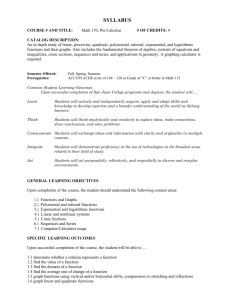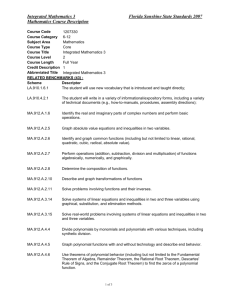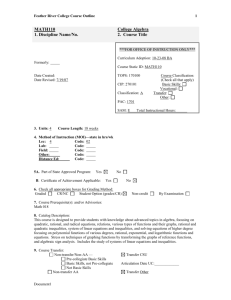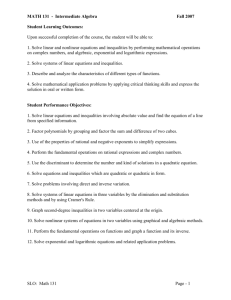Palomar Math 152 - geofhagopian.net
advertisement
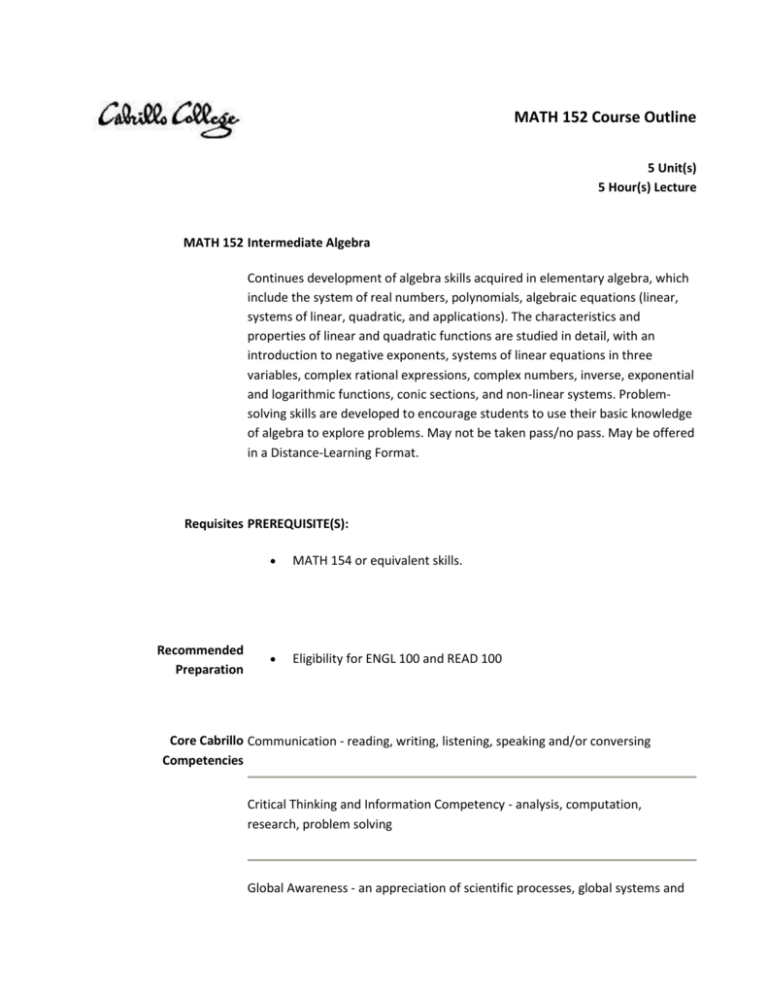
MATH 152 Course Outline 5 Unit(s) 5 Hour(s) Lecture MATH 152 Intermediate Algebra Continues development of algebra skills acquired in elementary algebra, which include the system of real numbers, polynomials, algebraic equations (linear, systems of linear, quadratic, and applications). The characteristics and properties of linear and quadratic functions are studied in detail, with an introduction to negative exponents, systems of linear equations in three variables, complex rational expressions, complex numbers, inverse, exponential and logarithmic functions, conic sections, and non-linear systems. Problemsolving skills are developed to encourage students to use their basic knowledge of algebra to explore problems. May not be taken pass/no pass. May be offered in a Distance-Learning Format. Requisites PREREQUISITE(S): Recommended Preparation MATH 154 or equivalent skills. Eligibility for ENGL 100 and READ 100 Core Cabrillo Communication - reading, writing, listening, speaking and/or conversing Competencies Critical Thinking and Information Competency - analysis, computation, research, problem solving Global Awareness - an appreciation of scientific processes, global systems and civics, and artistic variety Personal Responsibility and Professional Development - self-management and self-awareness, social and physical wellness, workplace skills Learning Outcomes 1. Evaluate appropriate techniques to apply to various types of equations and inequalities and produce and interpret solution(s). 2. Create, analyze, and solve a mathematical model describing a real life application. 3. Analyze and interpret mathematical and physical meaning from graphs of various functions. 4. Demonstrate algebraic literacy for subsequent math courses. Objectives 1. Manipulate linear, polynomial, and rational expressions. 2. Solve linear, polynomial, and rational equations and interpret solution(s). 3. Recognize differences among systems of equations and inequalities and solve using various strategies. 4. Perform arithmetic operations between polynomials. 5. Use factoring as a problem-solving technique. 6. Identify functions and relations and interpret their graphs using an assortment of techniques. 7. Construct graphs from data, equations, or a combination of functions. 8. Manipulate radical, quadratic, exponential, and logarithmic expressions. 9. Solve radical, quadratic, exponential, and logarithmic equations. 10. Model a physical problem using algebraic functions and equations. 11. Find the inverse of a one-to-one function and recognize the inverse relationship through composition. Content SIMPLIFYING EXPRESSIONS 1. Factoring algebraic expressions using a combination of greatest common factor, difference of two squares, sum or difference of two cubes, trinomial factoring, and grouping. 2. Solving equations and problems using factoring techniques. 3. Rules of integral and fractional exponents. 4. Scientific notation in application problems. 5. Synthetic Division of polynomials (optional). FUNCTIONS 1. 2. 3. 4. Evaluating using numerical and algebraic values. Identifying domain (inputs) and range (outputs) graphically. Functional notation in a variety of application problems. Equations and visual relationships for the inverses of linear, exponential, and logarithmic functions. 5. Function tests by looking at a graph, table, or equation. 6. Algebra of functions, including composition. 7. One-to-one functions graphically (optional). COMPLEX NUMBERS 1. Radical expression with a negative radicand in a+bi form. 2. Operations on complex numbers. 3. Powers of i. LINEAR FUNCTIONS, EQUATIONS, AND INEQUALITIES 1. Equation of a linear function given two ordered pairs, two data points, or a linear graph. Functional answer forms. 2. Compound linear inequalities joined by "and" or "or", and of the form c < ax + b < d. Algebraic, graphical, and interval notation for expressing inequalities. 3. Equation of a linear function given the slope and a point on the line. 4. Slope as a rate of change using appropriate units. 5. Linear inequalities in two variables. 6. Absolute value equations or inequalities. 7. Equation of a linear function given a point and a line perpendicular or parallel to the linear function. 8. Literal equations. QUADRATIC EQUATIONS AND FUNCTIONS 1. X- and y-intercepts and vertex of quadratic functions. 2. Quadratic formula, approximating irrational solutions, and writing complex solutions in a+bi form. 3. Quadratic models, maximum or minimum values, intercepts. 4. Application problems. 5. Solving quadratic inequalities, interval notation. 6. Graphing a parabola using the discriminant of quadratic formula (optional). RATIONAL EXPRESSIONS AND EQUATIONS 1. 2. 3. 4. 5. Operations on rational expressions. Simplifying complex fractions. Rational equations, checking for extraneous solutions. Application problems involving rational expressions. Rational inequalities (optional). RADICAL EQUATIONS AND EXPRESSIONS 1. Radical equation that produces a second-degree equation, checking for extraneous solutions. 2. Rational exponents and their relationship to radical form. 3. Simplifying radical expressions with emphasis on cube roots and higher. 4. Rationalizing numerator or denominator of radical expressions. 5. Operations on radical expressions. 6. Application problems involving the Pythagorean Theorem. EXPONENTIAL AND LOGARITHMIC EQUATIONS AND EXPRESSIONS 1. Solving basic exponential and logarithmic equations. 2. Evaluating basic logarithmic expressions, and converting between logarithmic and exponential form. 3. Exponential equation that requires the use of logarithms. 4. Logarithmic equation requiring properties of logarithms to condense, base e (ln x) or base 10 (log x) logarithms. 5. Solving for specific variables in exponential and logarithmic functions or relations. 6. Graphing basic exponential or logarithmic functions. 7. Graphical relationship between exponential and logarithmic functions. 8. Application problems involving exponential or logarithmic model. 9. Change-of-base formula. 10. Natural growth and decay models. SYSTEMS OF EQUATIONS AND INEQUALITIES 1. 2. 3. 4. Linear and nonlinear systems of equations. 3x3 system of equations. Graphing 2x2 system of linear inequalities. Application problems in two or three variables. CONIC SECTIONS 1. Graphing a circle by plotting the center and using the radius. 2. Graphing a parabola given by f(x) = ax2 + bx + c or x = ay2 + by + c by finding the vertex and another point. 3. 4. 5. 6. 7. Identifying conic sections without xy term. Distance between two points. Midpoint between two points. Graphing an ellipse. Graphing a hyperbola (optional). Assignments Out-of-class Assignments On a regular basis, homework assignments will be given which require students to: 1) analyze and study pertinent text material, solved examples and lecture notes; 2) apply the principles and skills covered in class by solving related problems. In-class Assignments 1. Participate in class discussion and analysis of example problems. 2. In preparation for homework, quizzes, and exams, students must regularly synthesize the material covered in class by solving problems in class. 3. Exams and quizzes. Students are expected to spend 5.00 hours in class and 10.00 hours outside of class. Evaluation Typical classroom assessment techniques Exams/Tests Quizzes Substantial writing requirements are not appropriate for this course. Students are assessed through demonstrations of problem solving ability on homework problems, quizzes, and exams. Required Assignments Class Work Home Work Grading Letter Grade Only Representative Texts Angel, Allen R, (2008). Intermediate Algebra (7th/e). Prentice Hall. ISBN: 9780136007623 Blitzer, Robert (2009). Intermediate Algebra for College Students (Custom 5th /e). Prentice Hall. ISBN: 9780536698230 History Approved: 09/02/2009 by Renee Kilmer CID: 2536



